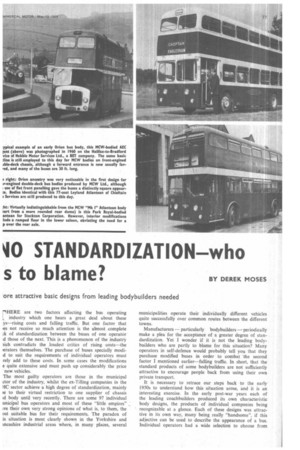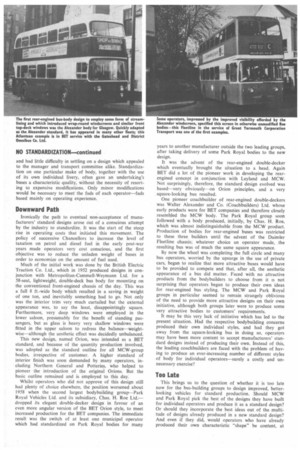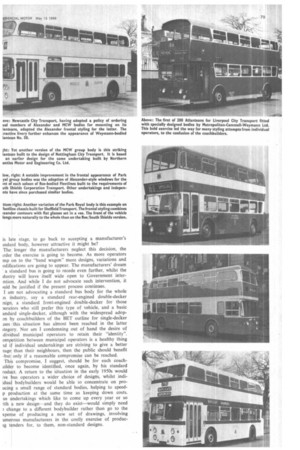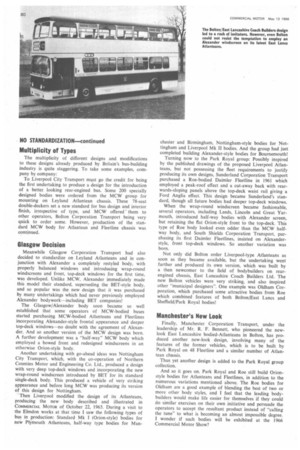W STANDARDIZATION who
Page 79

Page 80

Page 81

Page 82

If you've noticed an error in this article please click here to report it so we can fix it.
s to blame? BY DEREK MOSES ore attractive basic designs from leading bodybuilders needed
'HERE are two factors affecting the bus operating L industry which one hears a great deal about these ys—rising costs and falling traffic. But one factor that les not receive so much attention is the almost complete ;I of standardization between the buses of one operator d those of the next. This is a phenomenon of the industry iich contradicts the loudest critics of rising costs—the lerators themselves. The purchase of buses specially modi d to suit the requirements of individual operators must rely add to these costs. In some cases the modifications e quite extensive and must push up considerably the price new vehicles.
The most guilty operators are those in the municipal ctor of the industry, whilst the ex-Tilling companies in the FIC sector achieve a high degree of standardization, mainly te to their virtual restriction to one supplier of chassis body until very recently. There are some 97 individual unicipal bus operators and most of these "little empires" we their own very strong opinions of what is, to them, the ost suitable bus for their requirements. The paradox of is situation is most clearly shown in the Yorkshire and incashire industrial areas where, in many places, several municipalities operate their individually different vehicles quite successfully over common routes betweenthe different towns.
Manufacturers — particularly bodybuilders — periodically make a plea for the acceptance of a greater degree of standardization. Yet I wonder if it is not the leading bodybuilders who are partly to blame for this situation? Many operators in self-defence would probably tell you that they purchase modified buses in order to combat the second factor I mentioned earlier—falling traffic. In short, that the standard products of some bodybuilders are not sufficiently attractive to encourage people back from using their own private transport.
It is necessary to retrace our steps back to the early 1950s to understand how this situation arose, and it is an interesting exercise. In the early post-war years each of the leading coachbuilders produced its own characteristic body designs, the products of individual companies being recognizable at a glance. Each of these designs was attractive in its own way, many being really "handsome", if this adjective can be used to describe the appearance of a bus. Individual operators had a wide selection to choose from
NO STANDARDIZATION—continued
and had little difficulty in settling on a design which appealed to the manager and transport committee alike. Standardization on one particular make of body, together with the use of its own individual livery, often gave an undertaking's buses a characteristic quality, without the necessity of resorting to expensive modifications. Only minor modifications would be necessary to meet the fads of each operator—fads based mainly on operating experience.
Downward Path
Ironically the path to eventual non-acceptance of manufacturers' standard designs arose out of a conscious attempt by the industry to standardize. It was the start of the steep rise in operating costs that initiated this movement. The policy of successive Chancellors to increase the level of taxation on petrol and diesel fuel in the early post-war years made operators very cost conscious, and the first objective was to reduce the unladen weight of buses in order to economize on the amount of fuel used.
Much of the initial work was done by the British Electric Traction Co. Ltd., which in 1952 produced designs in conjunction with Metropolitan-Cammell-Weymann Ltd. for a 58-seat, lightweight, double-deck bus body for mounting on the conventional front-engined chassis of the day. This was a full 8 ft.-wide body which resulted in a saving in weight of one ton, and inevitably something had to go. Not only was the interior trim very much curtailed but the external appearance was, to say the least, disappointingly square. Furthermore, very deep windows were employed in the lower saloon, presumably for the benefit of standing passengers, but as glass is heavy very shallow windows were fitted in the upper saloon to redress the balance—weightwise—although the aesthetic effect was decidedly unbalanced.
This new design, named Orion, was intended as a BET standard, and because of the quantity production involved, was adopted as the standard outline for all MCW-group bodies, irrespective of customer. A higher standard of interior finish was soon demanded by many operators, including Northern General and Potteries, who helped to pioneer the introduction of the original Orions. But the basic outline remained and is employed to this day.
Whilst operators who did not approve of this design still had plenty of choice elsewhere, the position worsened about 1958 when the second largest bodybuilding group—Park Royal Vehicles Ltd. and its subsidiary, Chas. H. Roe Ltd.— dropped its elegant double-decker design in favour of an even more angular version of the BET Orion style, to meet increased production for the BET companies. The immediate result was the switch of at least one municipal operator which had standardized on Park Royal bodies for many years to another manufacturer outside the two leading groups, after taking delivery of some Park Royal bodies to the new design.
It was the advent of the rear-engined double-decker which eventually brought the situation to a head. Again BET did a lot of the pioneer work in developing the rearengined concept in conjunction with Leyland and MCW. Not surprisingly, therefore, the standard design evolved was based—very obviously—on Orion principles, and a very square-looking bus resulted.
One pioneer coachbuilder of rear-engined double-deckers was Walter Alexander and Co. (CoachbuiIders) Ltd. whose early products were for BET companies and therefore closely resembled the MCW body. The Park Royal group soon followed with a body produced, initially, by Chas. H. Roe, which was almost indistinguishable from the MCW product. Production of bodies for rear-engined buses was restricted to these three builders until the advent of the Daimler Fleetline chassis; whatever choice an operator made, the resulting bus was of much the same square appearance.
By now the wheel was completing the full circle and many bus operators, worried by the upsurge in the use of private cars, began to realize that more attractive buses would have to be provided to compete and that, after all, the aesthetic appearance of a bus did matter. Faced with no attractive products from the bodybuilders to choose from it is npt surprising that operators began to produce their own ideas for rear-engined bus styling. The MCW and Park Royal groups in particular seemed to remain strangely oblivious of the need to provide more attractive designs on their own initiative, although both groups later were to produce some very attractive bodies to customers' requirements.
It may be this very lack of initiative which has led to the present situation. Had the respective bodybuilding concerns produced their own individual styles, and had they got away from the square-looking bus in doing so, operators may have been more content to accept manufacturers' standard designs instead of producing their own. Instead of this, the leading coachbuilders are faced with the problem of having to produce an ever-increasing number of different styles of body for individual operators—surely a costly and unnecessary exercise?
Too Late
This brings us to the question of whether it is too late now for the bus-building groups to design improved, betterlooking vehicles for standard production. Should MCW and Park Royal pick the best of the designs they have built for individual operators and produce it as a standard design? Or should they incorporate the best ideas out of the multitude of designs already produced in a new standard design? And even if they did, would operators who have already produced their own characteristic "shape" be content, at is lte stage, to go back to accepting a manufacturer's m da d body, however attractive it might be?
The longer the manufacturers neglect this decision, the Lrder the exercise is going to become. As more operators mp on to the "band wagon" more designs, variations and odifi-ations are going to appear. The manufacturers' dream a s andard bus is going to recede even further, whilst the dust y will leave itself wide open to Government inter;tido . And while I do not advocate such intervention, it ul.ci be justified if the present process continues.
I am not advocating a standard bus body for the whole is industry, say a standard rear-engined double-decker :sign, a standard front-engined double-decker for those nerators who still prefer this type of vehicle, and a basic andard single-decker, although with the widespread adopan by coachbuilders of the BET outline for single-decker ises this situation has almost been reached in the latter itegory. Nor am I condemning out of hand the desire of dividual municipal operators to retain their "identity". ompetition between municipal operators is a healthy thing Id if individual undertakings are striving to give a better nage than their neighbours, then the public should benefit -but I only if a reasonable compromise can be reached.
This compromise, I suggest, should be for each coachuilder to become identified, once again, by his standard roduct. A return to the Situation in the early 1950s would 1 [ye us operators a wider choice of designs, whilst indiidua bodybuilders would be able to concentrate on proucin a small range of standard bodies, helping to speedp production at the same time as keeping down costs. us undertakings which like to come up every year or so nth a new design— and they do exist—would simply need ) change to a different bodybuilder rather than go to the xpense of producing a new set of drawings, involving umerous manufacturers in the costly exercise of producig tenders for, to them, non-standard designs.
NO STANDARDIZATION—continued Multiplicity of Types
The multiplicity of different designs and modifications to these designs already produced by Britain's bus-building industry is quite staggering. To take some examples, company by company: To Liverpool City Transport must go the credit for being the first undertaking to produce a design for the introduction of a better looking rear-engined bus. Some 200 specially designed bodies were ordered from the MCW group for mounting on Leyland Atlantean chassis. These 78-seat double-deckers set a new standard for bus design and interior finish, irrespective of type, and MCW offered them to other operators, Bolton Corporation Transport being very quick to order some. However, production of the standard MCW body for Atlantean and Fleetline chassis was continued.
Glasgow Decision
Meanwhile Glasgow Corporation Transport had also decided to standardize on Leyland Atlanteans and in conjunction with Alexander a completely restyled body, with properly balanced windows and introducing wrap-round windscreens and front, top-deck windows for the first time, was developed. Unlike MCW, Alexander immediately made this model their standard, superseding the BET-style body, and so popular was the new design that it was purchased by many undertakings which had never previously employed Alexander bodywork—including BET companies!
The Glasgow/Alexander body soon became so well established that some operators of MCW-bodied buses started purchasing MCW-bodied Atlanteans and Fleetlines incorporating Alexander-style frontal appearance and deeper top-deck windows—no doubt with the agreement of Alexander. And so another version of the MCW design was born. A further development was a "half-way" MCW body which employed a bowed front and redesigned windscreens in an otherwise Orion-style body.
Another undertaking with go-ahead ideas was Nottingham City Transport, which, with the co-operation of Northern Counties Motor and Engineering Co. Ltd., produced a design with very deep top-deck windows and incorporating the new wrap-round windscreen introduced by BET for its standard single-deck body. This produced a vehicle of very striking appearance and before long MCW was producing its version of this design for Nottingham.
Then Liverpool modified the design of its Atlanteans, producing the new body described and illustrated in COMMERCIAL MOTOR of October 22, 1965. During a visit to the EImdon works at that time I saw the following types of bus in production: Standard Mk I (Orion-style) bodies for new Plymouth Atlanteans, half-way type bodies for Man
chester and Birmingham, Nottingham-style bodies for Nottingham and Liverpool Mk II bodies. And the group had just completed building Alexander-style bodies for Bournemouth!
Turning now to the Park Royal group: Possibly inspired by the published drawings of the proposed Liverpool Atlan teans, but not possessing the fleet requirements to justify producing its own designs, Sunderland Corporation Transport purchased a Roe-bodied Daimler Fleetline in 1961 which employed a peak-roof effect and a cut-away back with rearwards-sloping panels above the top-deck waist rail giving a Ford Anglia effect. This design became Sunderland's standard, though all future bodies had deeper top-deck windows.
When the wrap-round windscreen became fashionable, several operators, including Leeds, Lincoln and Great Yarmouth, introduced half-way bodies with Alexander screen, but retaining the flat Orion-style front to the top-deck. This type of Roe body looked even odder than the MCW halfway body, and South Shields Corporation Transport, purchasing its first Daimler Fleetlines, insisted on Alexanderstyle, front top-deck windows. So another variation was born.
Not only did Bolton order Liverpool-type Atlanteans as soon as they became available, but the undertaking went further and produced its own version, which was built by a then newcomer to the field of bodybuilders on rearengined chassis, East Lancashire Coach Builders Ltd. The new Bolton vehicles were very striking, and also inspired other "municipal designers". One example was Oldham Corporation, which purchased some attractive bodies from Roe which combined features of both Bolton/East Lancs and Sheffield/Park Royal bodies!
Manchester's New Look
Finally, Manchester Corporation Transport, under the leadership of Mr. R. F. Bennett, who pioneered the newlook East Lancashire bodied-Atlanteans in Bolton, has produced another new-look design, involving many of the features of the former vehicles, which is to be built by Park Royal on 48 Fleetline and a similar number of Atlantean chassis.
Thus yet another design is added to the Park Royal group collection.
And so it goes on. Park Royal and Roe still build Orionstyle bodies for Atlanteans and Fleetlines, in addition to the numerous variations mentioned above. The Roe bodies for Oldham are a good example of blending the best of two or more other body styles, and I feel that the leading bodybuilders would make life easier for themselves if they could do similar exercises on their own initiative and persuade the operators to accept the resultant product instead of "calling the tune" to what is becoming an almost impossible degree. I wonder if such bodies will be exhibited at the 1966 Commercial Motor Show?




















































































































































